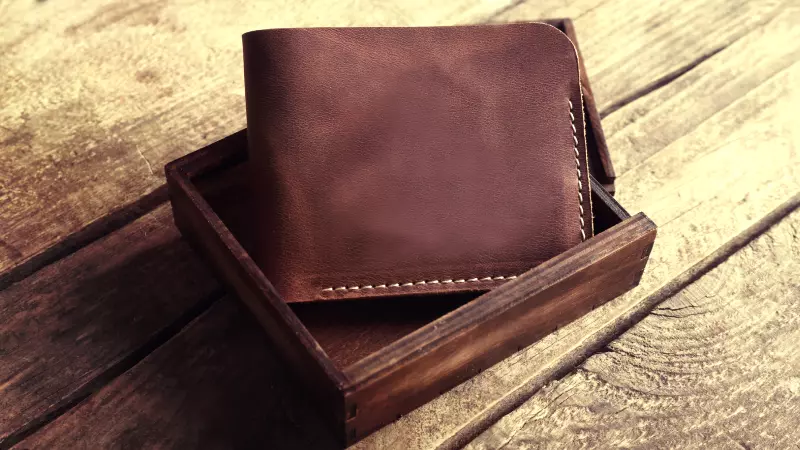How to Protect Your Leather Wallet
When was the last time you left your house without carrying your leather wallet with you? Probably a long time ago! Given the fact that we recognize the importance of a wallet, it makes sense for us to ensure that we can preserve its quality and shelf life for as long as possible.
This is particularly important if you have invested in a leather wallet. While leather is a popular material choice for wallets due to its luxurious as well as practical qualities, it is also one that requires quite a bit of maintenance.
Below, you’ll find the steps on how you can protect your leather wallet simply and sustainably:
- First, you need to ensure that your leather wallet is clean from a baseline perspective.
- Secondly, you should condition your leather wallet to ensure that your leather wallet ages gracefully.
- Thirdly, how you are storing your leather wallet is critical. This is especially so if you are looking to leave your wallet in storage for a longer period.
- Lastly, you should be aware of and avoid the common mistakes that lead to your leather wallet getting damaged.
If you can follow this guide even somewhat closely, we are confident that your beloved leather wallet will likely last you a long time while maintaining an appealing appearance.
1. Clean Your Leather Wallet
Leaving stains on your full-grain or genuine leather wallet can be detrimental to it in the long run. It’s a golden rule to clean stains and spills as soon as you notice them since untreated spills can result in permanent stains, ruining the entire appearance of your leather article.
If you have spilled a dye or bleach on your leather wallet, you must restore your leather wallet instead of cleaning it since these chemicals, unfortunately, affect it at a molecular level.
To ensure the leather remains free of any staining and lasts you for a long time, it is highly recommended for you follow the correct cleaning steps. Improper cleaning or usage of harsh chemicals can damage your wallet’s leather, rendering it unusable.
We strongly advise you to only clean your leather wallet on a need-only basis and not submerge it underwater or over-wash it with water and soap. Instead, use a saddle soap that cleans and renourishes your leather wallet, such as Bickmore Saddle Soap Plus.
We will cover common use cases and reasons why people find their wallets stained. With awareness, you can take steps to avoid undesirable outcomes by reducing exposure to said elements.
Stains from Jeans
The blue and indigo dye from your jeans can stain your leather articles, especially if they are light-colored. If you regularly keep your wallet in your denim jeans, there is a risk that your blue-dyed jeans may bleed onto your new beige wallet and stain it.
This is mitigated if your jeans have been through multiple washing cycles already. Loose dyes would likely already be accounted for. Therefore, be especially careful when you have just purchased a new pair of jeans as this is the likeliest window in which your wallet can get stained in this manner.
Food and Drink Stains
An exceedingly common cause of staining on leather wallets is food or drink spills. Your leather wallet can get food and wine stains or water spots on the surface as you keep it on the table while you dine. Keeping your wallet on dirty surfaces also allows it to pick up dirt and dust, giving it a grimy appearance.
Most people we speak to recognize that it is not recommended to keep a wallet in their back pocket when sitting down. This thus creates a conundrum in dining situations as the next logical and convenient option is to usually simply place the wallet on the table. This does, however, increase exposure and risk to staining.
In this situation, we recommend trying to find alternative solutions; if you are wearing a blazer or a jacket with pockets, you can consider storing your wallet there whilst dining.
Alternatively, whilst the side pockets of your pants or jeans might not be the most comfortable option in the world, it would leave your mind at ease that you are reducing the likelihood of damaging your leather wallet. Another practical approach is to keep your leather wallet in a bag, backpack, or purse.
Stains from Everyday Use
If you have a leather wallet for everyday use, you need to care for it properly since accidentally dropping it in the mud, splashing it with water, or dirt marks from improper handling can cause stains on the product.
Some dirt or moisture can also transfer from your hands onto your wallet as you handle your cash and cards. However, there are ways to remove water damage from leather.
2. Condition Your Leather Wallet
When you use a leather wallet daily, it is bound to get water splashes or sweat on it or be exposed to the heat or sun for a long time. This may cause the leather material to stiffen over time, ruining the luxurious texture and look of the leather.
Conditioning your leather wallet is the key to protecting it over a long period. Leather conditioners help to renourish the material with essential oils (that are removed by the presence and exposure to water molecules) and add a beautiful luster to it.
Conditioning the leather with regular use will also help it sustain its original look and protect against aging, cracks, and wrinkles. Start by selecting a high-quality leather conditioner and applying it to a lint-free cloth.
Lastly, rub the conditioner into the leather in circular motions using moderate pressure. This process will add a protective layer to your leather wallet, shielding it from foreign elements, such as grime, stains, and dirt.
3. Store Your Leather Wallet Properly
Proper storage of leather products is essential for more durable usage. Improper drying or too much moisture (sweat or water stains) can cause your leather wallet to grow mold which is much more difficult to remove from leather materials.
Therefore, if you are looking to keep your leather wallet in storage for some time, you must store it in a cool, dry, and ventilated environment. This is particularly important if you live in environments with high humidity levels.
You should also protect your wallet from heat and direct sunlight, as it can dry out the material and even cause fading. We recommend storing your leather wallet in a dust bag to protect it from accidental scratches and dust and dirt from gathering on it.
Try to avoid placing your wallets near window sills or around balconies where your wallet would be exposed to natural elements of the weather.
4. Common Mistakes To Avoid For Protecting Your Leather Wallet
Maintaining an expensive leather wallet is much more cost-effective and sustainable than replacing it with a new wallet. A well-maintained and aged leather wallet is also likely to develop a look and feel that a new wallet will not be able to replicate.
Prevention is better than cure; therefore, we have listed a few common mistakes you should avoid to ensure that your beloved leather wallet lasts you for years.
Sitting With A Leather Wallet in Your Back Pocket
Many people store their leather wallets in their back pockets and forget to take them out when they sit. Sitting on your leather wallet is harmful to your posture and your back.
This is because a wallet in a back pocket creates an uneven sitting surface, causing a tilt in the pelvic hip, which can lead to unequal weight distribution. Furthermore, this can also cause an inordinate use of your muscles around your lower back, leading to lower back pain which we could all do without.
Moreover, your wallet may also stain easily with your denim jeans or bend out of shape easily under your weight. If you have ever seen a U-shaped wallet, you can likely surmise it has been a wallet that has been sat on for an extended period.
Therefore, we recommend storing your leather wallet in the front pocket of your jeans, taking it out of your back pocket whenever you sit down or keeping it in a bag, purse, or backpack.
Improper Storage of Leather Wallet
Keeping a leather wallet directly under sunlight is not advisable since prolonged UV exposure can fade the leather and cause it to develop cracks. Overly humid environments can also cause mold growth which is extremely challenging to get rid of. We recommend storing your wallet in a dry, airy and shaded place.
Over-Washing Leather Wallet
Washing your leather wallet occasionally to get rid of stains and dirt is good for its long-term health. Still, over-washing any leather product can be detrimental to its structure and durability.
Over-washing leather can generally result in tougher water stains and even mold formation that may ruin a leather wallet. Our detailed article on how leather can be affected by excessive water exposure explains the potentially damaging effects it can have on your leather wallet.
Using Improper Washing Agents
You should always be careful regarding which washing agents or products you use for your leather articles. Nail polish remover, window cleaners, markers, hair spray, shoe polish, and disposable cleaning wipes or sponges carry harmful ingredients such as alcohol, chemicals, and acetone that can ruin the leather’s protective layer.
These types of ingredients are harmful to leather and cause discoloration or visible differences in texture. In the worst case, it can even leather your leather wallet brittle and dry, with visible cracking.
We advise against washing your leather wallet with only water, too. Instead, use dedicated leather cleaners and conditioners to renourish and maintain their shape and quality.
Don’t Overstuff Your Leather Wallet
As you know, leather is a natural material that is highly malleable. This means that your leather wallet will naturally adapt to the shape of its components and what you keep inside of it.
In order to protect its structural integrity and shape, we advise against overstuffing it with, notes, coins, cards, and accessories. Instead, fill it until reasonable and don’t cause it to bulge.
A leather wallet can stretch out if it’s overstuffed and can leave it looking bulgy and unappealing. While you’re able to shrink it back to its original shape, it may loosen the leather fibers over time. Therefore, keep the contents of your leather wallet to only what’s necessary.
Not Breaking In Your Leather Wallet
We also suggest that you properly break in your leather wallet, if it’s brand new. Feel free to read more in the linked article, where we share with you all the details on how to break in a leather wallet.

About Matthew
Co-Founder, Editor-in-Chief & Writer At Leatherskill
I’m a leather enthusiast turned artisan. Apart from crafting leather products, I’m passionate about writing in-depth guides and reviews on all things leather!

